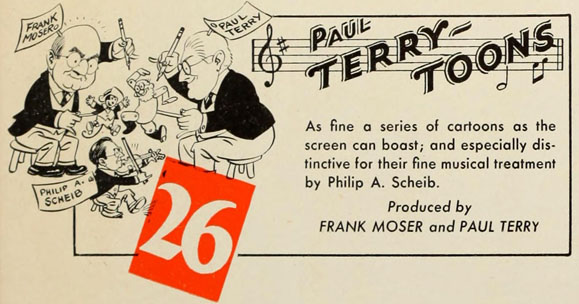
Today, we’re going to the East Coast, with an early sound Terrytoon!
Before he got into animation, producer Paul Terry quit high school to follow his older brother John’s footsteps as a newspaper cartoonist. At first, he traversed all over the Northeast as a photographer. When he moved to New York, he started to illustrate stories and drew the comic strip Alonzo for the New York Press. Like many cartoonists, Terry was influenced by Winsor McCay’s landmark Gertie the Dinosaur when he saw the film at a New York café.
Terry made his own animated short, Little Herman – a spoof of vaudeville magician Hermann – and sold it to the Thanhouser Company. His second film for Thanhouser, Down on the Phoney Farm, marked the first appearance of a character now known as Farmer Al Falfa (unofficially changed to “Farmer Gray” for television and Terry comics).
After producing films for the Bray Studios, A. Kay Company and Paramount Magazine, actor/writer Howard Estabrook suggested that Terry make an animated series based on Aesop’s Fables. Terry formed the Fables Pictures studio but its ownership was mostly in the hands of the Keith-Albee vaudeville circuit, warranting exhibitions for Terry’s new series.
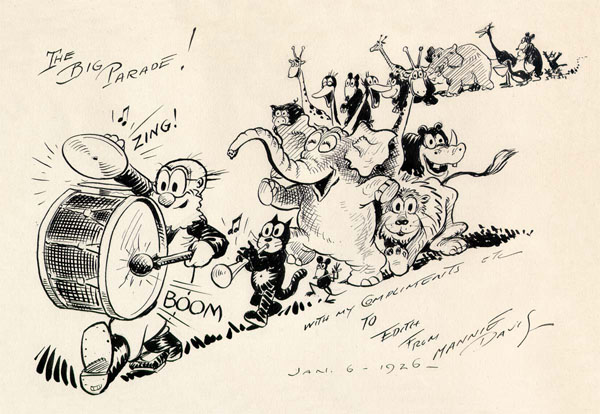
Mannie Davis drawing from the Fables era, circa 1926.
Besides the early 1921 entries, the series bore scant resemblance to the Aesop stories and were more of a pastiche of the stories, depicting animals with human flaws. Besides Terry’s Farmer Al Falfa, the films’ biggest novelty were the ambiguous morals that appeared at the end of each title— often more humorous than the real content. Since theater owners looked to short subjects to create a balanced program, Terry took advantage of the productivity an animation studio could achieve. A new Fable was released every week for eight years, with only a staff of 17 artists. A young Walt Disney admired the Fables so much that during the Laugh-O-Gram era, his staff would clip out sections from film prints and study them.
The frugal Terry was reluctant to transition to sound pictures. Producer Amadee Van Beuren’s corporation took over the Fables Studio and pressured Paul to release a Fable with a synchronized soundtrack. 1928’s Dinner Time was produced before, but released after Disney’s Steamboat Willie. The soundtrack for this cartoon, and several subsequent sound Fables seem more like silent cartoons with a cacophonous soundtrack tacked on. Van Beuren disagreed with Terry’s disinterest in adding sound to his cartoons, and a few months later, fired Paul from Fables Pictures, now re-named The Van Beuren Corporation.
Frank Moser – who animated roughly half of the shots in The Lorelei — worked as a newspaper cartoonist in Des Moines, Iowa and got his start in animation at William Randolph Hearst’s International Film Service in 1916. He was well known among his fellow artists as a “speed wizard” since he could supply an extraordinary amount of footage. He was the head animator of Fables Studio from the start. Moser was fired along with Terry and the two formed a partnership to create “Paul Terry-toons” at the Bronx in 1929. The studio relocated to New Rochelle five years later. Moser’s name was billed ahead of Terry’s name in publicity and the main credits.

Frank Moser’s Krazy Kat animation for Hearst.
Paul’s input influenced almost every department. He was heavily involved with story, so the Terrytoons were marred by repetition and formula. Many of the early entries use the “boy/girl/villain” conflict. Terry was not susceptible to experimentation. He ignored Moser’s suggestions to use color and develop regular characters.
In 1936, distributor Educational Pictures complained about the quality of Terry’s cartoons and announced they would terminate their contract. Moser feared the studio would close, and Terry offered to buy out his share of the company. A week later, Terry signed a new deal with Educational, promising to upgrade its product, and introduced two new characters: Puddy the Pup and Kiko the Kangaroo. Moser sued Terry and Educational for conspiring against him, claiming Paul wanted total control of the studio. He lost the case and retired to upstate NY to paint landscapes and create fine art until his death in 1964.
 Moser wasn’t the only staffer corrupted by Terry. Animator Jerry Shields was a sports cartoonist and illustrator for the Oakland Tribune before he met Paul’s brother, John, and assisted him with experimental animation in 1911. The two formed the Movca Film Service three years later. In 1916, Shields moved to New York. Paul offered him an opportunity to animate at the Fables Studio and continued to work with him at Terrytoons. As the studio advanced, Shields’ animation stagnated. He attempted to improve his drawing in some of the later cartoons, but his timing was still frozen in a crude, rudimentary style. Terry cut his salary in half because he knew no one else would hire him. Shields felt useless and redundant. He committed suicide by jumping out of his apartment in 1939.
Moser wasn’t the only staffer corrupted by Terry. Animator Jerry Shields was a sports cartoonist and illustrator for the Oakland Tribune before he met Paul’s brother, John, and assisted him with experimental animation in 1911. The two formed the Movca Film Service three years later. In 1916, Shields moved to New York. Paul offered him an opportunity to animate at the Fables Studio and continued to work with him at Terrytoons. As the studio advanced, Shields’ animation stagnated. He attempted to improve his drawing in some of the later cartoons, but his timing was still frozen in a crude, rudimentary style. Terry cut his salary in half because he knew no one else would hire him. Shields felt useless and redundant. He committed suicide by jumping out of his apartment in 1939.
Bill Tytla and Art Babbitt are renowned for their influential artistry at Disney’s. The two became friends at Terrytoons and shared an apartment together in the Bronx. Art started at Terry’s in October 1929 and remained there until Disney hired him in July 1932. Bill worked for Terry at the Fables Studio by March 1923, but felt discontented with his animation. He traveled to Europe in 1929-30, studying painting and sculpture. When he returned to New York, Paul offered him a job at Terrytoons, and his work showed a vast improvement. His dancing/singing scenes in The Lorelei have a fluidity that builds on comedic distortion, but Terry often assigned him sequences based on their complexity. In contrast, Babbitt’s animation for Terry was stylized but stiffer in motion. Tytla’s influence was beneficial for Terry. His style cemented the look of the cartoons up the later 1950s. Tytla devised the “eyelashes and eye-bags” look so common to Terry’s characters.
Ferdinand Horvath, known as a jack-of-all-trades at Disney for background, layout, and character design, is credited for two scenes in this cartoon. He spent two-and-a-half years in Siberian POW camps during WWI and arrived in New York in 1921. He had various jobs – painting window frames, caulking/painting boat hulls, creating stage effects and set designing — before joining the Fables Studio in 1926. He worked with Terry until 1933, when he moved to Disney’s studio and contributed to many of their pivotal works. He left in 1937 and went on to design models and layouts for Columbia/Screen Gems, and to sculpt puppets for George Pal’s Puppetoons.

1931 Terry staffers (L to R): Jerry Shields, Bill Tytla, Frank Moser, Charles Sarka. Behind: Art Babbitt, unknown, Paul Terry.
When Golden Age animation studios were celebrated and examined in later articles and books, Terry’s studio faced the most scorn. Critics and historians dismissed the cartoons as bland and derivative.
A recent rise in appreciation and interest for the studio has revealed many talented artists and hidden gems, despite the producer’s tight business ethics. Composer Phil Scheib, often overlooked amongst other animation musicians, didn’t have a full symphony orchestra. He was forced to write original scores, since Terry refused to pay for copyrighted music. There were rare exceptions in the early sound Terrytoons, as evident here in the clever usage of Wagner’s The Flying Dutchman.
It is great to see newcomers and fans re-evaluating Terry’s immense library of cartoons with mostly positive feedback on social media. Perhaps the history books will be updated soon to reflect this change in opinion and appreciation.
To look at an almost chronological view of the Terrytoon output, visit this YouTube channel and watch for yourselves.
Enjoy this week’s breakdown video! I’ll be busy arranging my college graduation these next couple of days, so I’ll have to sit the next one out, but I promise I will be back after that.
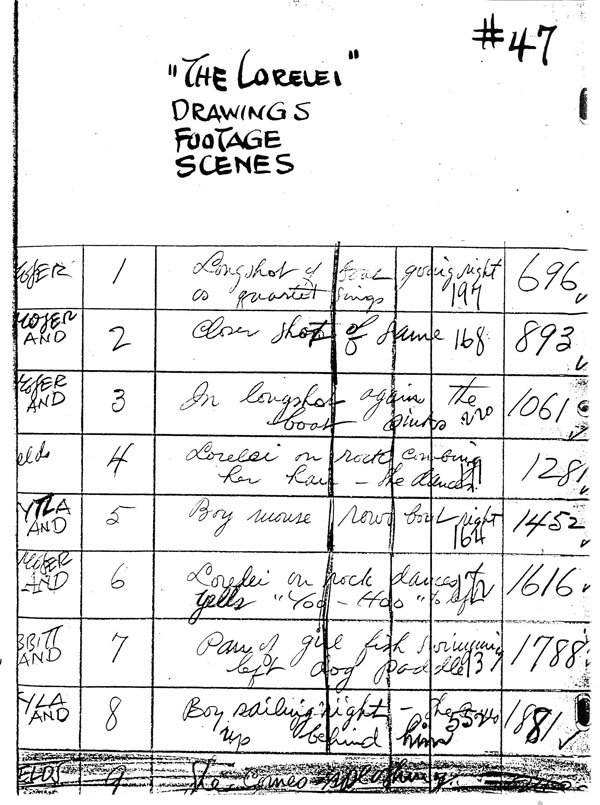

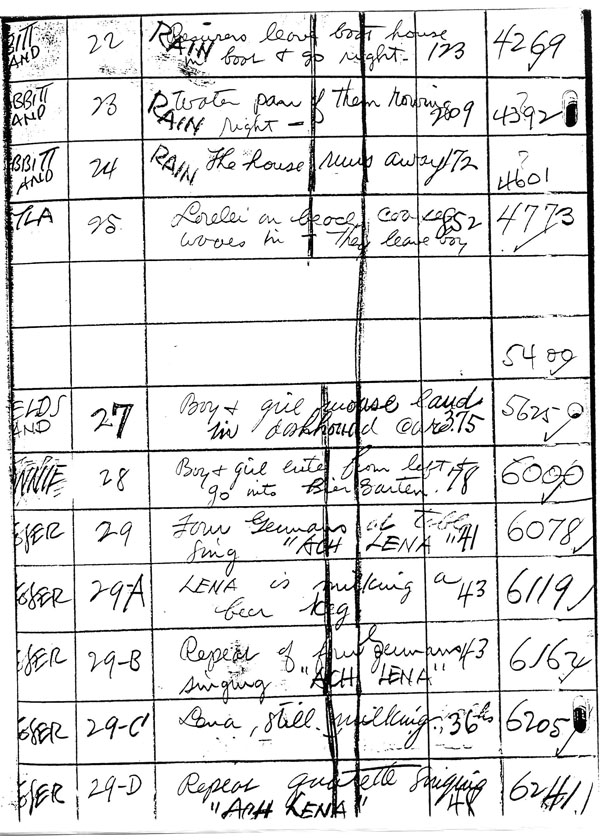
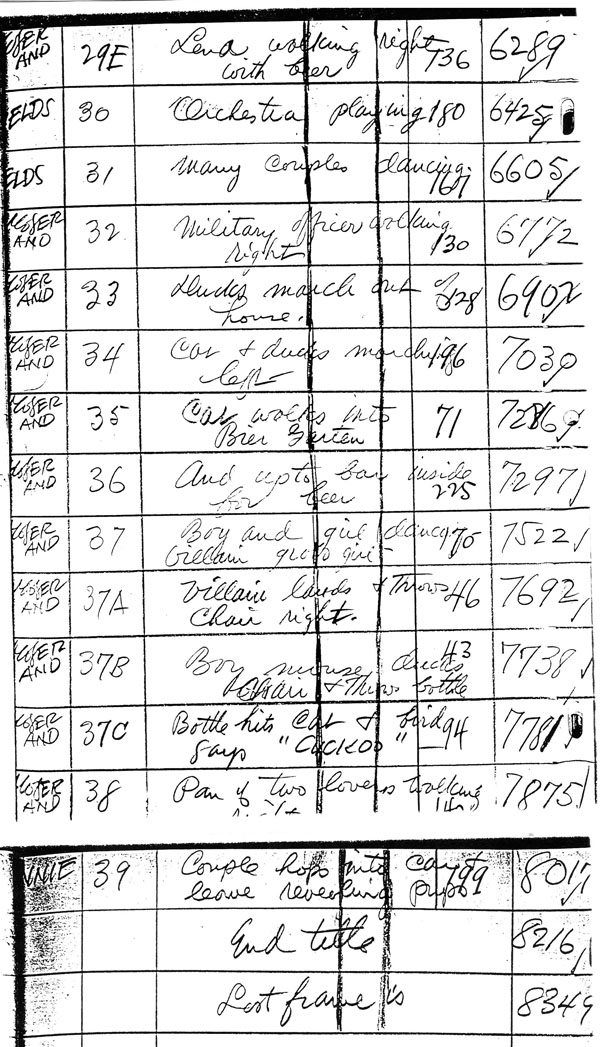
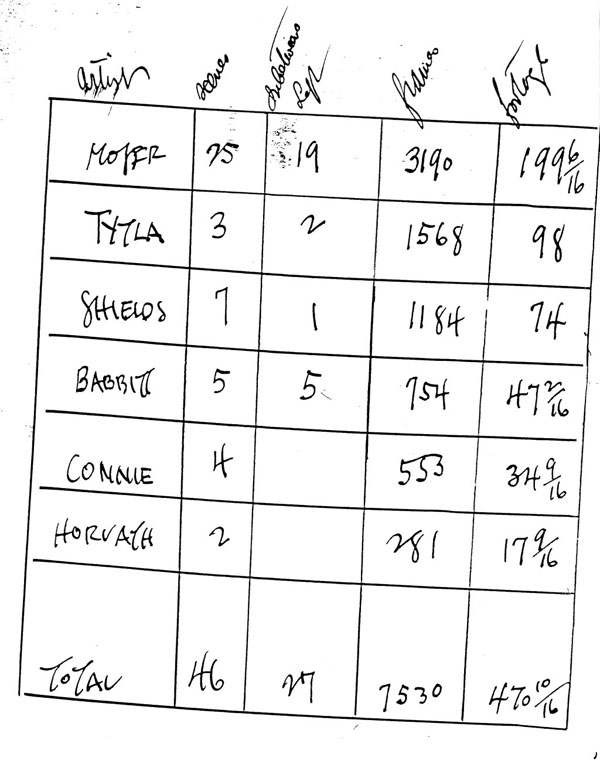


 DEVON BAXTER is a film restoration artist, video editor, and animation researcher/writer currently residing in Pennsylvania. He also hosts a
DEVON BAXTER is a film restoration artist, video editor, and animation researcher/writer currently residing in Pennsylvania. He also hosts a 





















































































This is fantastic. If those are Tytla’s eye designs that made it up through the Deputy Dawg era, then who developed that distinctive Terrytoon run with the skating feet and wrists that bend back impossibly? That style more or less lasted through to Deputy Dawg, with the added variant of the arms flopping over characters’ heads as they ran.
Devon, where did you find the info. that Jerry Shields committed suicide? That’s something I didn’t know. I thought he lived longer than that. His stiff style with the popping headturns and absolutely NO overlapping action was a Terry hallmark. I love Tytla’s early animation, HE really loosened up the Terry characters and put a great deal of overlap and follow-through on drapery into his dance animation. He also made the little girl mice more appealing. Frank Moser’s stuff always looks like animated newspaper cartooning to me, his drawing is funny and very ink-line sketchy, too bad Terry done him dirt.
One of the main reasons that Terry’s cartoons are thought repetitive today is that the only versions of the cartoons are the CBS negatives, which in many instances are CENSORED. CBS removed all ethnic caricature, anything sexy, anything too violent from the black and white Terrytoons (even some of the color ones), and replaced the missing footage by repeating OKed sequences twice and sometimes three times! By the way, just about all the film prints that are now posted for FREE on the Internet, were from my collection. So you all may now enjoy what I paid hundreds of dollars for and years of storage costs for nuttin’.
Regarding the use of music from “The Flying Dutchman,” I think most 19th century orchestral music must have been in public domain or not subject to royalty payments for movie-score use since one hears a lot of it used in early talkies, both cartoons and live-action. In Terry’s NOAH’S OUTING (1930) near the end we hear a few bars from “Die Walkure” of “Wotan’s farewell and magic fire music.”
Thanks for putting that into perspective, Russell!
FACT UPDATE: Charles Brubaker informed me that the ALONZO strip Paul Terry drew was in the San Francisco Call, not the New York Press. Matter of fact, Terry recollected in an interview that he had drawn the strip for New York papers, but his memory might have been hazy at the time.
Some nicely goofy visual ideas here, like driving around in a Dachshund. (Not a Datsun…)
You’re as sweet as sauerkraut?!?! Not much of a pick-up line. Was that Mae Questal
doing the voice? At least this mouse, unlike Daffy Duck in ‘A Coy Decoy’, was able to
get a long little doggie.
you should also reload that